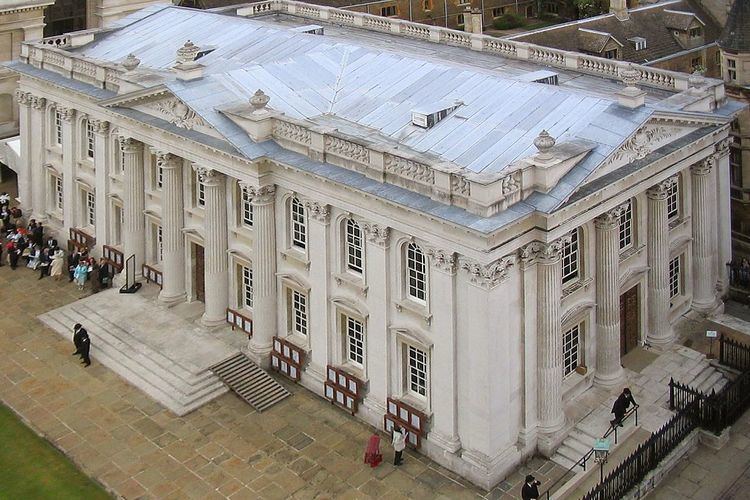Type Academic Opened 1730 | Completed 1730 Construction started 1722 | |
 | ||
Address Senate House Passage, Cambridge CB2, UK Similar University of Cambridge, Church of St Mary the Great - Ca, King's College Chapel, Mathematical Bridge, The Backs | ||
The Senate House of the University of Cambridge is now used mainly for degree ceremonies. It was formerly also used for meetings of the Council of the Senate.
Contents
Location and construction
The building, which is situated in the centre of the city between King's and Gonville and Caius Colleges, was designed by architect James Gibbs, based to an unclear extent on designs by the gentleman-architect Sir James Burrough, and built in 1722–1730 by Gibbs in a neo-classical style using Portland stone. The ceremony to lay the first stone was performed by Thomas Crosse, then Vice-Chancellor, on 22 June 1722. The site was previously used for houses, which were purchased by an Act of Parliament, dated 11 June 1720. It was officially opened in July 1730, although the western end was not completed until 1768.
The Senate House was originally intended to be one side of a quadrangle, however the rest of the structure was never completed. It forms part of the Old Schools Site. It is a Grade I listed building.
History and usage
The Senate House is now mainly used for the degree ceremonies of the University of Cambridge. It was also formerly used for meetings of the University's Council of the Senate.
Graduation ceremony
Graduates receiving an undergraduate degree wear the academic dress that they were entitled to before graduating: for example, most students becoming Bachelors of Arts wear undergraduate gowns and not BA gowns. Graduates are presented in the Senate House college by college, in order of foundation or recognition by the university, except for the royal colleges.
The 31 colleges process to the Senate House in the following order:
During the congregation, graduands are brought forth by the Praelector of their college, who takes them by the right hand, and presents them to the vice-chancellor for the degree they are about to take. The Praelector presents graduands with the following Latin statement, substituting "____" with the name of the degree:
The now-graduate then rises, bows and leaves the Senate House through the Doctor's door, where he or she receives his or her certificate, into Senate House passage.
At the University of Cambridge, each graduation is a separate act of the university's governing body, the Regent House, and must be voted on as with any other act. A formal meeting of the Regent House, known as a Congregation, is held for this purpose.
University's 800th Anniversary
As part of the University's 800th anniversary celebrations in 2008, the side of the Senate House was illuminated with a light show, illustrating aspects of the history of the university.
2010 Student Protests
The Senate House was occupied for 11 days in November 2010 by a group of around 200 university students, Cambridge residents and sixth-form students as part of the wider student protests across the UK in opposition to the planned spending cuts to further education and increase in tuition fees introduced by the Conservative-Liberal Democrat coalition government in England.
Maths tripos results
At the end of the academic year, class-lists for most degrees are posted up on the outer wall of the building. The results of Part II and Part III of the Mathematical Tripos, however, are read out to the waiting students from the balcony of the Senate House, after which piles of class-lists are thrown to the ground like confetti in a time-honoured manner.
Austin Seven
A battered Austin Seven van was found on the apex of the Senate House roof on the morning of 8 June 1958. The van had been placed there the night before by a party of engineering students from Gonville & Caius College. They found the derelict Austin Seven in Harston and towed it into Cambridge. They removed the engine and rear axle to make it light enough to winch up to the roof, and hauled it up using cables and scaffolding they'd stolen from King's College. It took the University a week to get the van down and the prank received lots of media attention at the time.
